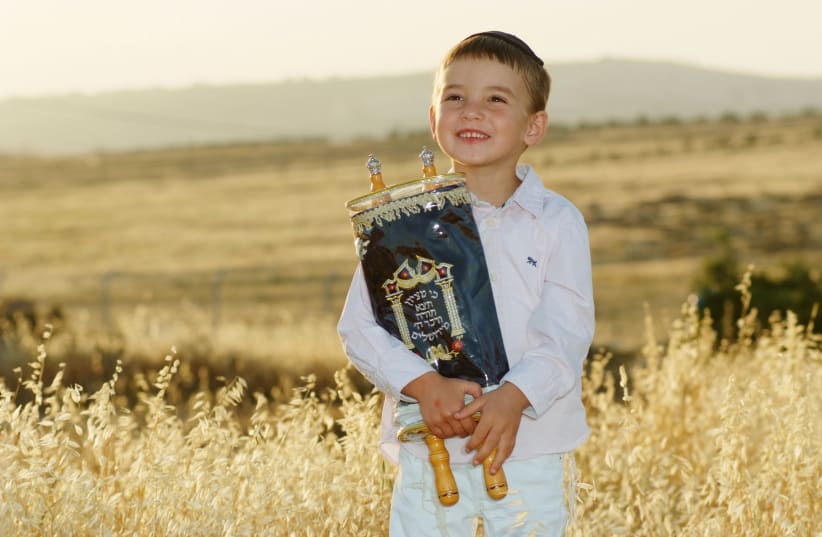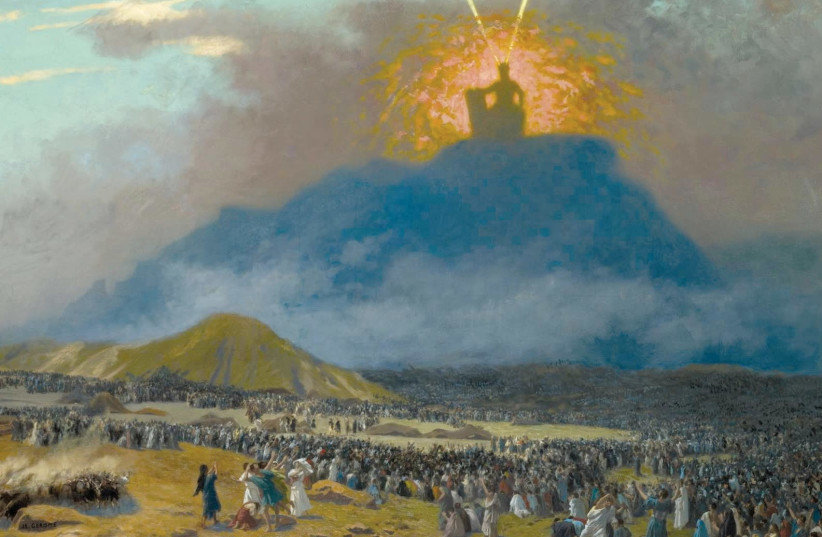This Thursday evening, all of us, sons and daughters of the Jewish people, will begin celebrating Shavuot – “the time of the giving of our Torah.”
On this day, the most important formative event in the history of the Jewish people took place: the revelation at Mount Sinai. On this occasion, the entire nation heard the Ten Commandments – the essence of the entire Torah. The Bible describes the Ten Commandments as a unique revelation of God in which the words were heard from God Himself. Of course, God has neither a body nor a mouth. This means that the revelation was direct, and not indirect through an emissary like Moses.
When the Torah describes the preparations for the revelation at Mount Sinai, it tells of the Children of Israel who wandered through the desert and reached the foot of the mountain – “and Israel encamped there opposite the mountain” (Exodus 19:2). The word for “encamped” is written in the singular. Rashi comments on the singular verb “vayihan,” which differs from the other descriptions of the Israelites’ encampments in the desert written in the plural, “vayahanu”:
“‘And Israel encamped there’ – Heb. vayihan [the singular form, denoting that they encamped there] – as one man with one heart, but all the other encampments were [made] with complaints and with strife” (Rashi on Ex. 19:2).
“‘And Israel encamped there’ – Heb. vayihan [the singular form, denoting that they encamped there] – as one man with one heart, but all the other encampments were [made] with complaints and with strife.”
Rashi on Exodus 19:2
Shavuot: Finding unity at the foot of Mount Sinai
Camping at the foot of Mount Sinai was special. There was unity “as one man with one heart.” Rabbi Pinchas Horowitz, rabbi of Frankfurt at the end of the 18th century and disciple of the Maggid of Mezeritch, one of the founders of the Hassidic movement, explains in his book Panim Yafot that this unity was a necessary condition for receiving the Torah. He compares the Jewish nation to the human body – “as one man”: when each of the organs exists alone, there can be no life. Only when all organs unite are they able to function as a living body. The people of Israel are also like this: When the nation is divided and conflicted, it does not function as a living body and is not worthy of receiving the Torah. Only when the nation lives in unity does it become worthy of receiving the Torah.
FOR MANY, “unity” serves as a superficial slogan. Unity is not created when each person expects others to be considerate of him, but when he himself learns to accept others and be tolerant of them. In other words, the condition for receiving the Torah is proper interpersonal conduct that begins with the individual and gradually spreads and affects the entire nation.
The Talmud tells of a second-century sage named Rabbi Hiyya who noticed the lack of schools for children and worried about the Torah being forgotten in future generations. In those days, they would learn from parchment scrolls, and Rabbi Hiyya had to produce such scrolls for study. This is what is told about him: He sowed cotton, and when it grew, he made hunting nets out of it. In these nets he hunted deer, fed their meat to poor orphans, and from the leather, he produced scrolls on which he wrote the Five Books of the Torah and from which he taught children (Baba Metzia 85).
Note that there is one detail in this story that is not part of the process of creating the scrolls: feeding venison to poor orphans. This may be a noble act, but why is this detail told as part of the process? Why does it matter to us who ate the meat? The answer is that, indeed, acts of hessed, of loving-kindness, are an inseparable part of Torah study. A person who wants to connect to the Torah and have the right to receive it must focus not only on Torah study but also on proper relations with others, especially with the needy and less fortunate.
Throughout the Jewish world, the Ponevezh Yeshiva in Bnei Brak is famous, one of the largest and most important yeshivot. But not many people know that the person who laboriously founded the yeshiva, Rabbi Yosef Shlomo Kahaneman (1886-1969), established alongside it welfare institutions intended initially for children survivors of the Holocaust and later for children of immigrants and needy families. In so doing, he embodied the path of Rabbi Hiyya, which does not separate acts of kindness from the development of the world of Torah.
On Shavuot, it is customary to read the Book of Ruth. This scroll tells of King David’s family roots, with Ruth at the center of the scroll – a woman who joined the Jewish people out of loyalty to her widowed and poor mother-in-law, and from whom the line of kings of the House of David would emerge. Many reasons have been given for reading the scroll on Shavuot, but it seems that what was written in the midrash provides the most appropriate reason.
The midrash asks: “This scroll – there is neither impurity nor purity in it, neither prohibition nor permission, so why was it written?” In other words, what does the Book of Ruth come to teach us? What benefit are we supposed to derive from it? Is this just a historical story?
The answer of the sages of the midrash is: “To teach you how good the rewards are for those who perform hessed, acts of loving-kindness” (Midrash Ruth Rabbah 2). The anonymous woman who behaved kindly with her mother-in-law merited having the kingdom of the House of David come from her.
When we stand on Shavuot and recreate in our hearts the revelation at Mount Sinai and the acceptance of the Torah, we are called upon to remember that the Torah does not stand alone, alienated from humanity. The Torah is a Torah of life, a Torah of grace; that to receive it, one must, first of all, be a “human being” in the full sense of the term. ■
The writer is rabbi of the Western Wall and holy sites.

